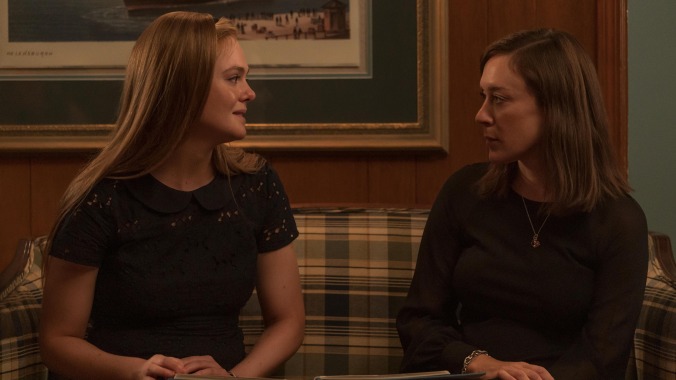Hulu’s bleak The Girl From Plainville struggles to justify its existence
Elle Fanning and Colton Ryan are the heart and soul of an otherwise rocky true-crime series

In the closing scene of The Girl From Plainville’s first episode, a young Michelle Carter (Elle Fanning) practices a mournful Glee performance in front of the mirror. She’s hoping to get every emotional beat right to convey grief over the death of her 18-year-old boyfriend, whom she encouraged to attempt suicide over a series of text messages. It’s a sad and disturbing moment and an effective representation of what Hulu’s limited series does best—that is, rigorously explore of the mental health of the two troubled teens at its core.
The show is based on the infamous “texting-suicide” case and Carter’s trial for involuntary manslaughter after Conrad Roy died in 2014. Not even a decade old, this story has already been extensively covered in the media, a 2017 Esquire article that inspired the series, and HBO’s 2019 docuseries I Love You, Now Die. The biggest challenges, then, are making the case for whether the story needs to be retold and gleaming new insights into the investigation and its subjects.
The Girl From Plainville tries to justify its existence by leaning heavily on Michelle and Conrad’s (Colton Ryan) individual struggles, told through their point-of-view, and what drew them to each other. The show is most compelling when it sheds light on such unexplored angles in surprisingly surreal ways. It succeeds in bringing a humane element to a puzzling crime without sensationalizing it. And for the most part, this is because of rousing performances by Fanning, Ryan, and Chloë Sevigny (who plays Conrad’s mother, Lynn Roy).
Michelle and Conrad enter a long-distance relationship after meeting in Florida while on vacation with their families. The two lived about an hour away from each other in Massachusetts, so their entire dynamic evolves mainly through texting. Instead of seeing their numerous chats pop up plainly on the screen, The Girl From Plainville smartly puts both actors in the same room when they’re messaging. The duo creates their own little world while on their phones, so it makes sense the conversations feel like they’re happening in real-time (to them and to the audience). It’s an effective way for Fanning and Ryan to establish their characters’ dependencies on one another.
However, in trying to ascertain Michelle and Conrad’s toxic dynamic, The Girl From Plainville narratively flounders with overwrought script choices (think lots of unclear timeline-jumping). It’s despairing and moves along at a crawling pace. The eight hourlong episodes lose impact, especially when the last three are essentially reenacting Michelle’s trial (also the focus of HBO’s docuseries). In the end, it’s a foreboding, straightforward true-crime drama with only hints of innovative storytelling. The show’s intriguing points about how both teens viewed their looming relationship get lost in the shuffle.
Conrad a.k.a. Coco is an affable and capable young man fighting inner demons he doesn’t quite understand. He suffers from depression and has a difficult time connecting with his father, Conrad Roy II (Norbert Leo Butz). Once Michelle enters his life, he finds an outlet to discuss his pain with her, including suicidal thoughts. In one scene, Coco remarks that he doesn’t know if it’s a good or bad thing that she understands him so well. Ryan is remarkably tender and melancholic throughout.
As for Michelle, she feels like an outcast at school. She tries way too hard to be liked but her efforts tend to push people away. With Conrad, she becomes his center of attention. The Girl From Plainville has Michelle griping about possibly being bisexual, adding a different layer to what might be driving her decisions. In episode five, she shows off a vision board for her future featuring an image from Glee. (Yes, Ryan Murphy’s musical series factors into the show multiple times.) Michelle’s obsession with Rachel and Finn’s tragic love story is indicative of her impressionable mind. She likes to believe (with awareness or not) in a fairytale imagination where her poisonous romance is “epic.”
Fanning is terrific in her portrayal of a tricky character. Her transformation is quite jarring in the trial scenes—the makeup and costume department leaves no stone unturned here. But the show has nothing distinctive to say about its protagonist or her motives, so it raises lots of questions without providing conclusive answers. Is she purposefully evil while condoning, often pushing Coco to kill himself? Or does Michelle see this as an act of love in a warped, infatuated teenager way? Perhaps it’s the result of the medications she’s taking, or she simply wants the attention of her peers as the grieving girlfriend.
The show attempts to discern these elements with endless zoom-in shots of Fanning vigorously crying or running on the treadmill. Oof, the running: That repetition gets tedious quickly. It’s also reminiscent of another Hulu drama, The Handmaid’s Tale, which consistently relies on leading star Elisabeth Moss’ close-ups to do the heavy lifting. Fanning has an excellent serious face, but a committed actor can’t save a weakly put-together narrative, and The Girl From Plainville suffers because of this.
It’s an undoubtedly sad watch. Michelle and Conrad’s early interactions are brutal, given the knowledge of how it all eventually plays out. Fanning and Ryan’s chemistry (an awkward thing to praise in the context of the real situation) makes the show immensely watchable, as does Sevigny’s profound display of Lynn’s pain and confusion over Coco’s death. The whole cast is splendid actually, which might be the biggest reason to tune into The Girl From Plainville, despite its unsteady and drawn-out run.